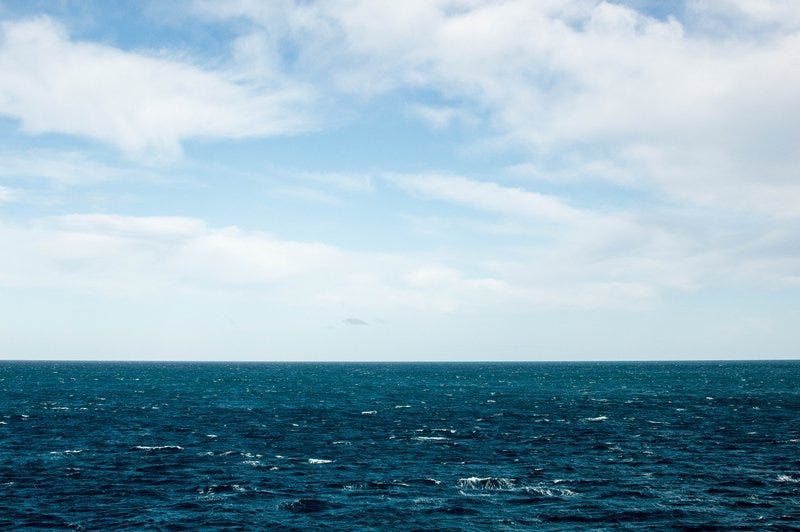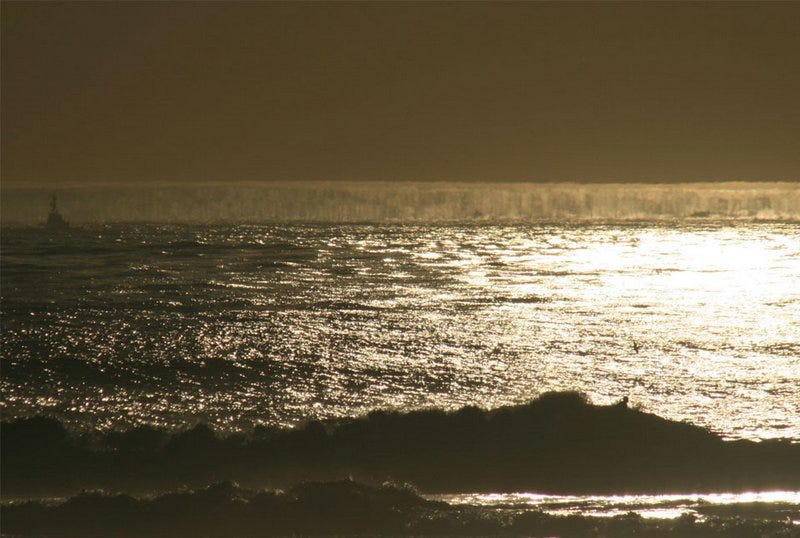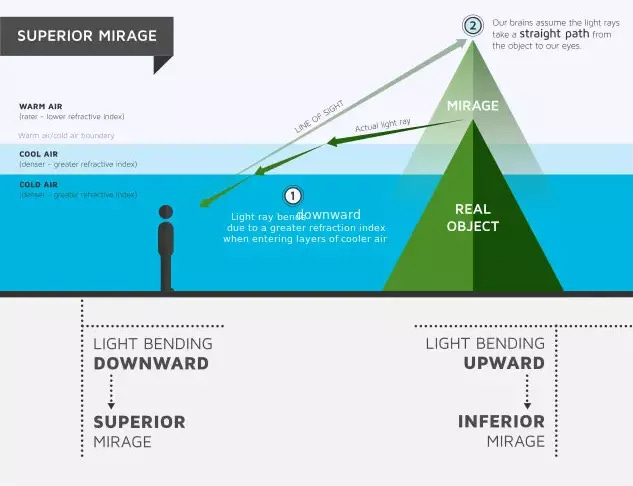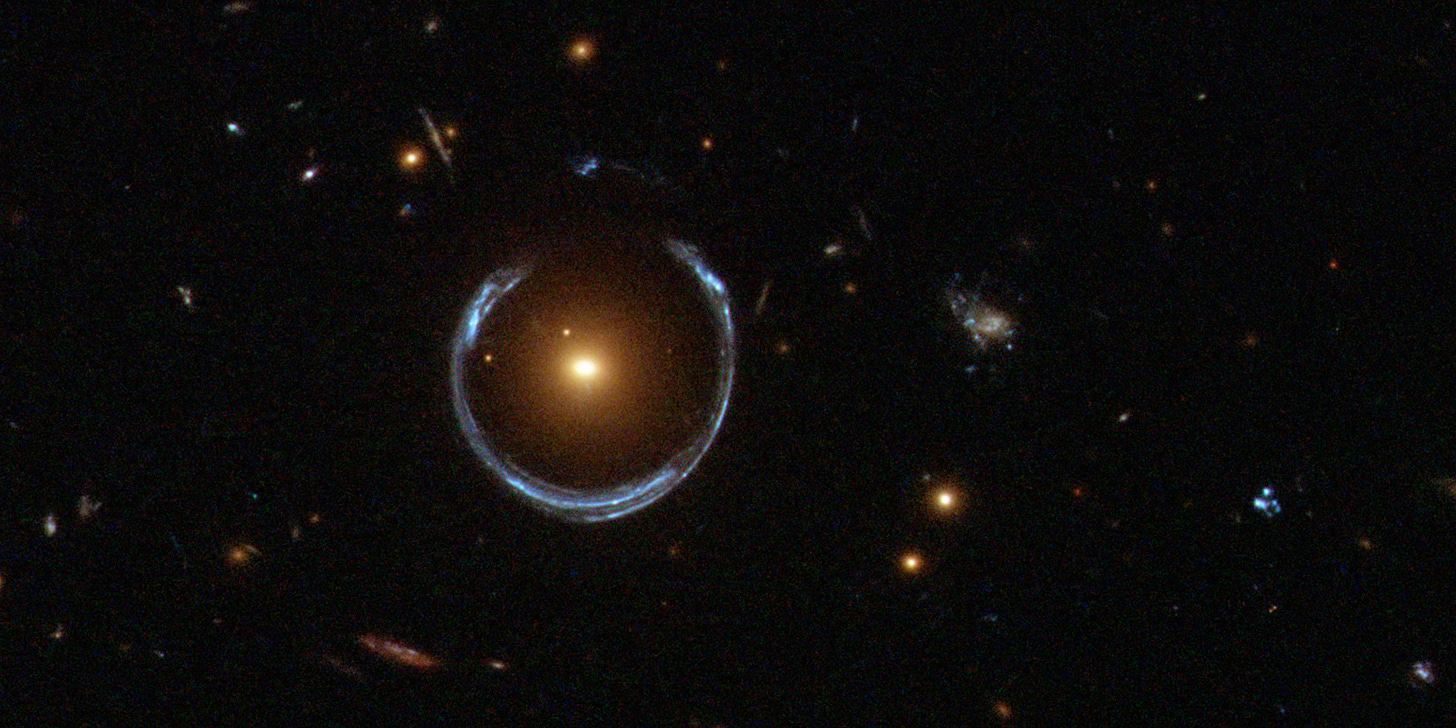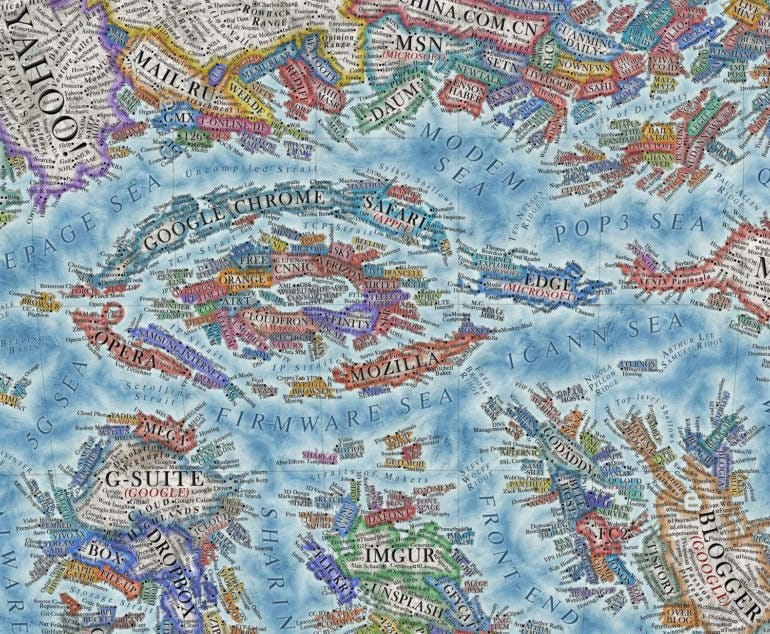The Science Of Seeing What Isn't There
An Everything Is Amazing encore edition
Hello! This is Everything Is Amazing, a newsletter about science, curiosity, and the bottomless joy of going “WOW” at a thing you never knew until now.
For the fourth time, here’s part of a 6-week roundup of previously published stories that kicked up a few more wows than normal, while I’m taking a break between seasons 5 and 6. Here’s what happened in season 5 and here’s what’s coming next - and here, too.
(The first three roundup stories were on this imaginary town that somehow refused to stay fake, the ludicrously arbitrary reasons the tops of our maps point North, and this very strange thing happening in the sky above Glasgow).
And today, staying with sky stuff, let’s squint at the horizon in search of floating cities, flying ships and even the back of our own heads.
Imagine you’re going for a stroll somewhere, one Autumn morning.
It’s good to be out, even if the air’s cold enough to make your breath steam. For the first time this year, it feels like winter’s on the way. Everything’s aglitter with frozen dew, and the sky is the colour of faded denim. It’s so, so clear today. You feel like you could see forever.
You work your way up a track that ends atop a coastal cliff, one of the few high points in this region. And as you get to the top, with the sea before you - you see a city, far in the distance.
It’s an absolutely magnificent sight, with only two things wrong with it.
Firstly, you’ve never seen a city here. Not that close. The nearest one is over a hundred miles away. The visible horizon from up here is, what, thirty miles? What’s going on?
And secondly, there’s that rather disconcerting way it’s hovering in the air. You can actually see sky underneath it - and under that, the sea.
How do you react to this?
As a modern human who took Science at school, I reckon you’d presume there was some scientific explanation. Maybe it’s like how the road ahead seems to turn into water on a really hot day. Or maybe you remember how water bends straws, and you get thinking Hm, well, in a sense the air around us *is* a liquid, or more correctly a fluid, so why couldn’t it…
But let’s hold a second. Perhaps your real first thought is woah, His Dark Materials was right! Or woah, Comstock really built Columbia. Or perhaps it’s a glimpse of Heaven. Or you wonder if you’ve been sent a vision, for some reason that’s yet to be revealed to you.
An over-rationalist person would be dismissive of such interpretations - and in doing so, throw out 90% of the value of having a human imagination.
This unnerving What-If space between first seeing a thing and feeling certain you know what you’re looking at is the realm of pure Art. It’s where writers go hunting for metaphors, similes and analogies, to bring their descriptions to life in someone else’s mind when the bare facts don’t suffice. (Isn’t it interesting that they have to do that? How even in non-fiction, what we call “good writing” is bolstered by so much that’s imaginary?)
It’s a place kids know well, until they have it machined or ridiculed out of them by the worst of our educations systems and by peer pressure. It’s a place adults know well, when they’re lost in a good made-up story to the point their brain is temporarily, but completely, fooled into thinking it’s describing reality. It’s the workplace of Artists, and also of anyone using their imagination to accomplish anything - which describes, what, everyone? So we all go there. Frequently.
(It’s also where we think the craziest conspiracists, Flat Earthers etc. spend all their time, hence this world of imagination’s somewhat tarnished reputation. But to cling to something that’s so easily and rigorously contradicted by almost everyone else, you have to dig your heels in and refuse to imagine. Complete certainty, whether it fits the evidence or ignores it, is a tantrum against thinking itself.)
So, please, enjoy this moment of Not Yet Knowing. Enjoy how it makes you feel. (“What does it mean?”)
But, as Nature-sleuth Tristan Gooley would say, there are clues here. With any unusual phenomenon, a good rule is to ask what else is unusual. What’s different about today? Aha - that it’s bitterly, unseasonably cold? OK, what else?
Observe now. Record now. Judge later.
If accounts are true, that’s exactly what Jesuit priest Father Domenico Giardina did on August 14, 1643. Looking across the Strait of Messina from Sicily, he suddenly saw “a city all floating in the air, and so measureless and so splendid, so adorned with magnificent buildings, all of which was found on a base of a luminous crystal.”
As he watched, the city shimmered and became a garden. And then a forest. And finally a landscape of vast armies, locked in combat over the ruins of buildings - before the whole thing disappeared completely.
As Marina Warner writes in her book Phantasmagoria (2008), Father Giardina reacted like any scientist (or Gooley), writing all his observations down to ponder later. His conclusion was that minerals and salts “rise up in hot weather in vapours from the sea to form clouds, which then condense in the cooler upper air to become a mobile specchio, a moving, polyhedrical mirror.”
That’d be a credible stab at an explanation even now. In 1643, 61 years before Isaac Newton’s Opticks was first published, it’s astonishing.
Some modern critics think he might have been high. By the 17th century, Jesuits had started drinking the tea of a psychoactive plant from Ecuador called Guayasa (similar to Yerba Mate). Only, there’s little evidence that any Jesuit priests were drinking it, or that Father Giardina was knocking it back at the time. (It sounds like the same sniffy he was clearly on drugs argument that plagued Paul “Double Rainbow” Vasquez.)
Or perhaps he just imagined the whole thing. No way of telling now.
Except - other people have seen these cities too. Modern people. They’ve even captured them on film:
And here, from Alaska in 2016:
So these visions are real?
Yes. They absolutely are. They’re not someone’s fevered imaginings. There are now thousands of credible observations of them captured on camera, not just by floating-city enthusiasts but by journalists, sailors, businessmen on the way to work, everyone who was around at the time, on a scale that defies even the most paranoid imaginings of any conspiracy theorist (you’d hope, anyway).
Look, here’s a photo from NASA’s website:
I don’t know about you, but having seen that bit with the waves in Interstellar, this sight would make me lose my lunch (and I’m not sure from which end). RUN! TIDAL WAVE INCOMING.
If you’re sceptical that these are all legit, I applaud you. Photos and video are so easily faked nowadays. At least one atmospheric scientist is unsure one of those videos up there from China isn’t fabricated. (And as a general demonstration of what’s possible these days - deepfake Tom Cruise, anyone?) Also, me telling you these are real - well, I could be deluded. Or lying! You’d be right to question my opinion and ask for something that backs it up. Asking questions is always good, when you have the opportunity (or privilege) to do so.
So by way of evidence that these visions aren’t fictitious, here’s one of the more trustworthy news services from my country, reporting on a floating ship in March 2021.
OK. Let’s go back to the imaginary You, standing on that hill.
Your school-science rememberings were indeed on track here. It’s exactly like the heat haze mirage, and exactly like the way a straw seems to bend when it’s stuck in a glass of water & viewed from the side.
When light passes into a medium with a different density, it refracts to a different angle (you may dimly remember this as Snell’s Law, from school).
You were also right in considering the unusual temperature a clue. It’s telling you there’s a temperature inversion, where a layer of colder air is hugging the ground (a reverse of the normal state of things). And since cold air is denser than warmer air, that band of coldness is bending light to form a Superior Mirage (above), where objects over the horizon seem much closer, and can even appear to be hovering high in the air.
Learning that light bends is a profoundly unsettling thing. Take the phrase I’ll believe it when I see it, often delivered as a rock-solid truism: if you actually can see it happening, surely that’s reality? This bias is so ingrained in us that when we see a magic trick, we are absolutely fooled because, hell, we can see it happening.
Magicians rest their entire livelihoods on our lack of ability to disbelieve what our eyes are telling us - and are often willing to go to court to protect their secrets.
But really, we’re tricking ourselves. What we see is, most times, exactly what we see. How we interpret what we see is the source of confusion here, and the thing magicians manipulate by focusing our attention in sneaky ways we’re barely aware of…
And in the case of the superior mirage known as the Fata Morgana (from Morgan Le Fay, King Arthur’s treacherous, scheming half-sister), we assume we can see castles in the air instead of a curving beam of light.
Incidentally, if you’re lucky enough to see a Fata Morgana, keep watching it. As the air moves around, the moving light will create some very strange effects:
Maybe some part of you is thinking Meh, scientific explanations kill the fun. I want an actual floating castle! (I certainly hear that. So here’s an actual one. Sort of.)
I reckon this un-funness is largely a myth. The more you dig into modern science, the weirder it usually gets.
Take ducts, the scientific term for those bands of cold or warm air near the ground. As Robert Macfarlane notes in his book Landmarks:
“Because the curvature performed within a thermal inversion is stronger than the curvature of the earth’s surface, light rays can be continuously guided along the duct, following the earth’s own curvature, without ever diffusing up into space. In theory, therefore, if your eyes were strong enough to see that far, a duct would allow you to gaze around the whole earth and witness your own back and shoulders turned towards you.”
(And presumably if that were true, around that back & those shoulders you’d also see a cumulative picture emerge as that light continued to circle the world, seven rotations a second. This is…probably best not thought about for very long. Our minds aren’t designed that way.)
But the biggest optical illusions can only be seen with space telescopes - the ones that point outwards, into a universe so befuddling that humanity should be scared to look.
Take the truly barmy cosmic mirage known as gravitational lensing, where the light from a single object twists as it passes a source of gravity strong enough to bend it. Here’s the most perfect example I’ve seen:
This eye-like object is actually two galaxies, one far behind the other. The red one in the centre is nearest - and as the light rays from the more distant blue galaxy (which by a fluke is almost exactly behind the red one from our perspective) pass it on all sides, they all get bent inwards towards us.
The result looks to us like a ghostly horseshoe - but that’s really just a single dot of blue light being stretched in ways that are almost too fantastical to comprehend.
All of this is backed up by hard science. That doesn’t mean it’s the certain truth, of course (good science isn’t dogmatic), but it does mean it’s been challenged from all sorts of directions by all sorts of clever people, and what’s left is their best hypothesis about what’s actually out there…
And what’s out there looks absolutely wild.
(Nobody should ever accuse scientists of lacking imagination. Especially cosmologists. If the Olympics had an event called Conceptual Gymnastics, cosmologists would have cabinets at home stuffed with gold medals.)
This is why optical illusions are the focus for season 3 of this newsletter. Not just because they’re amazing to look at (and then some), and not just because I’m a science nerd (and then some)…but because curiosity frequently requires the suspension and delay of disbelief in order to truly flourish.
Yes, you are seeing this, even if it looks absolutely impossible.
No, you don’t know what the hell you’re looking at. (And right now that’s a feature, not a bug.)
And yes, this is a weird state of mind to be in, in a world that prides itself on certainty and knowing and finding answers instead of sitting with questions.
As I hope to show you again and again, the world is frequently a lot stranger than it looks - and as you’ll see, it looks pretty damn strange indeed when you pay close attention to it. And as I said previously: “Isn’t that the joy of optical illusions, that they can pull the rug away from you like that? How often does that happen in life? Isn’t it a thrill?”
Prepare yourself for a lot of rug-pulling.
(And a lot of cool pictures.)
If that has your head spinning, I have a paywalled piece that asks the surprisingly tricky question Hey, what does the Internet actually look like?
From now until September, all paid subscriptions to Everything Is Amazing are 10% off.
That’s access to all those paywalled articles, to my upcoming non-fiction storytelling course, to chapters of my first book How To Be Rained On when they’re ready, and a personal ‘curiosity call’ to motivate you to chase your own nerdiness in a similar way, as I explained here.
It’s also the only form of support I’m using to keep this newsletter going. No ads, no sponsors, nothing - which keeps me accountable to you alone. So if you’ve enjoyed any part of Everything Is Amazing and want to see it grow and get more ambitious/reckless/weird, a paid subscription at any level is the best way to help me keep this thing alive.
Click below to sign up with a 10% discount. Thank you!
Images: Anchorage Daily News; NASA/Mila Zinkova; Ludovica Lorenzelli, DensityDesign Research Lab/Wikimedia; Joe LaCour/Earth Sciences Picture Of The Day; ESA/Hubble & NASA; Stephen Crowley; Tomas Eidsvold.


